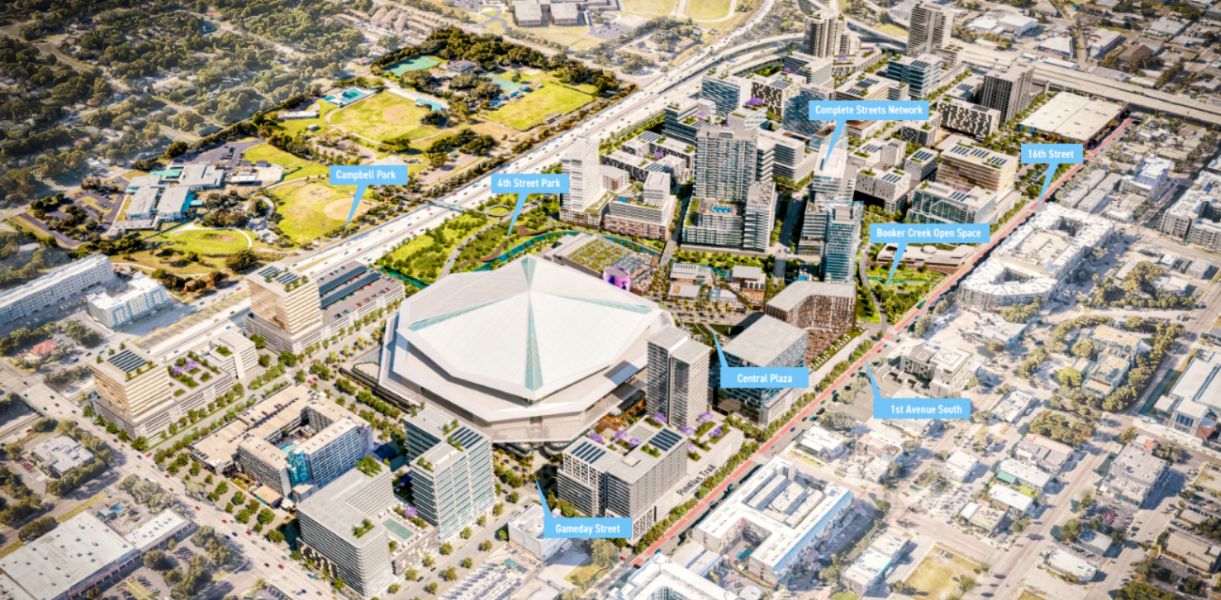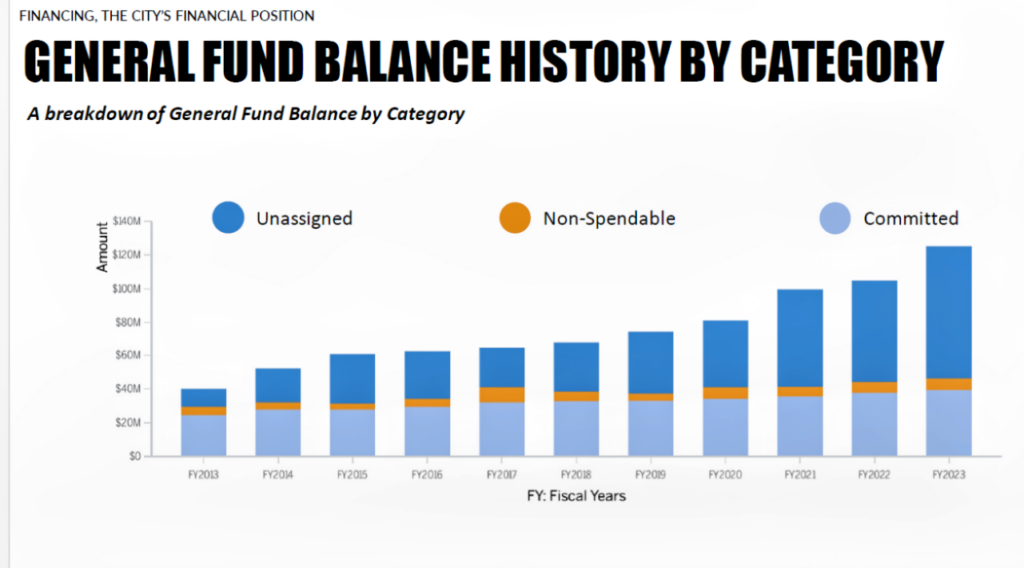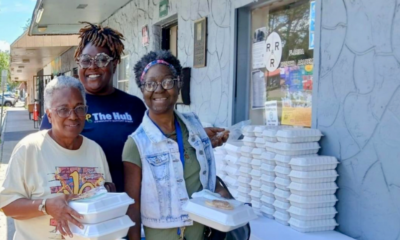Thrive
Can St. Pete afford its Gas Plant redevelopment contribution?

According to Bank of America, Raymond James Financial and city administrators, St. Petersburg is well-positioned to contribute $287.5 million toward the Historic Gas Plant District’s over $6.5 billion redevelopment.
However, some council members remain unconvinced of the city’s ability to service that debt over three decades of economic uncertainty without raising taxes or taking much-needed money from the general fund. That was the overarching theme at the May 8 development agreement workshop, mostly excluding plans for a $1.3 billion ballpark.
If approved, the city would spend $142 million upgrading site infrastructure, including a $12 million sewage lift station. The total debt service estimate is $189.5 million, which jumps to $683.8 million when including the ballpark. For comparison, the Tampa Bay Rays and Hines development team will invest $5.4 billion, excluding interest and stadium costs.
“The important takeaway here is that the resources will be sufficient,” said Tom Greene, assistant city administrator.

A graphic highlighting St. Petersburg’s strong financial position. Screengrab, city documents.
The city’s fund balance to expenditure ratio is 30.7%, compared to a 20.1% average among peer markets. Anne Fritz, debt financing director, said St. Petersburg’s credit issuer ratings – Aa2 (Moody’s) and AA+ (Fitch) – are as strong as its overall financial position.
Administrators submitted project financing plans to the agencies, and Fritz said both upheld the current ratings. They also selected Bank of America and Raymond James to lead a team of bond underwriters.
“Bank of America had responded that the city’s proposed structure is prudent and conservative,” Fritz said. “They expect the true interest cost to actually be significantly lower than the city’s assumption.”
She said Raymond James came to similar conclusions. The city will finance most of its contribution through a property tax-exempt bond issuance, which it will repay through tax increment financing (TIF) supported by increasing property values. Officials used the common funding mechanism for the St. Pete Pier.
They believe property tax revenue will increase by 7% annually through 2042, allowing the city to pay off its project debt by 2055. Fritz said that is a conservative estimate based on the area’s growth.
The Gas Plant sits within the Intown Redevelopment Area (IRA), which runs east from Tropicana Field to the Pier. It includes most of the downtown waterfront.
Greene said the area’s average annual tax revenue increase is about 8.3%. He noted its 41-year history includes several years of consecutive decreases, including the Great Recession.
Fritz said the city’s credit ratings did not decline during that period. “We feel comfortable and confident that 7% is achievable … based on historical performance.”

A graphic highlighting the city’s expected return on investment. Screengrab, city documents.
Intown TIF coffers contain $67 million. However, Pinellas County contributed about 44%.
The IRA is a joint initiative between county and city officials to spur downtown growth. It ends in 2032, and Pinellas officials can then spend their share elsewhere.
The city plans to extend the IRA until 2042 without the county’s contribution. Administrators said that would ensure debt repayment flexibility.
After accounting for other bond issuances, Fritz said the city would have $75 million in TIF funding by 2042. Green said officials must “come up with” $21 million in “other non-ad valorem revenue” to service the Gas Plant’s debt after the IRA sunsets.
The city will set aside $50.4 million in land sale proceeds for debt repayment. HR&A Advisors, an independent consulting firm, expects the city to receive $475 million in gross property taxes and TIF revenue throughout the 30-year project. The estimated total economic benefit is $680 million.
Councilmember Richie Floyd noted that local leaders established the IRA to revitalize the now vibrant and growing area. He said that “trapping so much wealth” downtown feels “unjust.”
Greene said officials could eschew the TIF funding if property tax increases meet the 7% target. Fritz expects the Gas Plant redevelopment to foster additional growth.
Greene added that the Trop’s sprawling parking lots could arguably constitute “blight.” He said the goal is to capture a “portion of the development that’s going to happen and have it pay for itself.”

A before and after view of the Tropicana Field site.
Greene said the remaining $54.6 million in land sale proceeds could offset funding shortfalls. Councilmember Lisset Hanewicz asked how a catastrophic event, like a hurricane, could impact the financing plan.
Fritz said the city’s budget includes emergency funding, and officials could utilize economic stability dollars. They replenish those coffers during periods of prosperity.
“These have been really good years in terms of ad valorem growth,” Hanewicz said. “There is no guarantee that trajectory will continue.”
She said the city would contribute $240 million to the IRA instead of its general fund, which pays for critical citywide services. Hanewicz also noted that administrators based financial projections on target development goals rather than the minimum requirements.
Administrators would lock in a 4.33% interest rate for 10 years and could refinance terms under improved lending conditions. Councilmember Copley Gerdes said he appreciated his colleagues’ concerns but said the project is more than a 30-year investment.
“In 2054 and further, we’re getting over a $100 million return on investment, and it continues to go, but the bond payments aren’t there anymore,” he added. “I’m looking at it in 2060, 2070 … and that return on investment is exponential.”








J
May 19, 2024at4:00 am
The baseball team can leave as far as I am concerned..Anywoo both City administrations past and present are always lapping like puppy dogs when developers propose high end development but when it gets to addressing what the city needs as far better storm water and sewage repair and replacement they use those funds to give to developers to build more high rises..and what seems like MLB
S. Rose Smith-Hayes
May 15, 2024at7:48 pm
Please Do Not sell any of the land to Anyone, Please!!!!!!Keep it City owned, Please
Alan DeLisle
May 15, 2024at6:42 am
All there is risk for the city and no risk for the Rays/Hines. It doesn’t get any worse. The city got steamrolled.
Tim Cody
May 14, 2024at4:41 pm
Why would any taxpayer fund some billionairs project,so they can make billions more!
Ryan Todd
May 14, 2024at4:02 pm
Send the Rays to Oakland – if they’ll have them.
HAL FREEDMAN
May 14, 2024at3:57 pm
From this issue of the Catalyst: “Hines sells Tampa industrial park for $94.5 million
May 13, 2024 – Houston-based Hines, the global development firm working with the Tampa Bay Rays to redevelop St. Petersburg’s Historic Gas Plant District, has sold the Tampa Commerce Center for $94.5 million. A corporate entity linked to New York-based Blackstone, an investment management company, acquired the property in an all-cash deal. Hines leased the industrial park to the Ball Corporation, an aluminum packaging manufacturer. ”
That’s what they’ll do with the non-stadium acreage we are selling them at a huge discount. This is an awful deal for St. Petersburg taxpayers and a great deal for Hines and Stu Sternberg.
HAL FREEDMAN
May 14, 2024at3:52 pm
Copley Gerdes is quoted: “In 2054 and further, we’re getting over a $100 million return on investment, and it continues to go, but the bond payments aren’t there anymore,” he added. “I’m looking at it in 2060, 2070 … and that return on investment is exponential.”
That’s a joke. In 2054, 30 years from now, the Rays will be looking for a new stadium. It will be the same old story…the bonds are paid off on the Trop, let’s go into debt again. In 2054, the cycle will repeat!
Josh Cruz
May 14, 2024at6:49 am
I this is a bad deal for St. Pete property owners. We have so many blighted areas of the city and many major water/flooding projects we will need to undertake in the future, that I as a working professional, will also be expected to have my taxes pay for that among the many things that happen over 30 years, the percentages thrown out on growth are sophomoric, only Lisset on that council really understands the magical thinking of these projections. It unreasonable to sink this much money into a baseball stadium (vs a convention center for example) at any rate for a team most here seem not to care about, and do Gen Z and millennials even like baseball (they are the future audience after all), not really, when compared to football and hockey. I drive in rush hour traffic to Tampa to see the Bolts, I’d never do the same for the Rays. The whole concept at the site seems like 15 years ago it would have been an opportunity, today it’s a drag on our finances as a city in a precarious position, 7% annual growth (Ha!)That would place DTSP in the ranks of major metros, but this city still has no great jobs producer or major companies here creating real growth. The city needs to focus on securing our city for the future not throwing a party over 30 years and us hardworking home and business owners footing the bill.
Peter Kent
May 13, 2024at5:15 pm
This article mentions a $683.8 million total bond cost with the Rays-Hines deal.
Also, the city will need to enlarge and modernize its water and sewer systems to handle the 6000 new housing units in the HGPD. Understand that is estimated at $600 million.
Then there is the $760 million of listed improvements to storm water system needed to stop the current flooding and to reduce the damage from a hurricane hit. Sounds like the city needs to borrow at least $2.044 Billion.
And there is the amount the city will need to borrow after a hurricane strike to help rebuild itself and the damage to homes of low- and moderate-income residents if it wants them to recover. But after the hurricane, the city’s property values and borrowing capacity will be greatly reduced. Where will the city politicians who voted for this Rays-Hines give away be hiding then?
The ability to repay these bonds are based on the downtown “Incity” CRA property value increasing at 7% a year. At that rate, the value of the downtown will double in 7 years, be four times todays value in 20 years, 8 times in 30 years. Where have such a rapid increase ever been observed? What happens to property values if there is another 2008 financial crisis, 2020 Covid epidemic, or hurricane hit? Assessable values for downtown condos under homestead status can increase only 3% a year. Does that mean the rest of the property values will increase at say 15% a year? Is Mayor Welch or Anne Fritz personally guaranteeing this 7% increase?
It is unfair for half of the increase in downtown property taxes from all those luxury condos to be given to the Rays rather spread equally to pay for city services throughout the city. The rest of the city has to pay increased taxes to cover these lost taxes.
The new property taxes from a successful development will go to pay for the needed increases in police, fire, water, sewer, parks, etc. city services. To call these increases in taxes “a return on investment” like interest fails to understand economics.
Lauren
May 13, 2024at4:56 pm
This is a very bad deal for taxpayers. Let the citizens VOTE on this.
JohnB
May 13, 2024at4:12 pm
“Councilmember Richie Floyd noted that local leaders established the IRA to revitalize the now vibrant and growing area. He said that “trapping so much wealth” downtown feels “unjust.””
Giving away “so much wealth” downtown seems to be even more “unjust.” TIF financing is re-allocating increased property taxes which could be used to improve other infrastructure and costs that are paid by taxpayers. There is no guarantee of all that TIF materializing. It did not happen before.
“She (Hanewicz) said the city would contribute $240 million to the IRA instead of its general fund, which pays for critical citywide services.” There is a perfect example of using taxpayers money to fund this boondoggle without voter approval. It is not at all obvious as a good deal for taxpayers.
“…expects the city to receive $475 million in gross property taxes and TIF revenue throughout the 30-year project. The estimated total economic benefit is $680 million.” That is a net (theoretical) benefit of $205 million over 30 years. Maybe. Maybe not. That is a lot to bet for a relatively small return.
The truth is that the City/County is willing to give the land away to developers who may or may not provide expected returns and benefits.
The city invested $20 million in BayWalk, the developer invested $8 million and it was sold to Bill Edwards (Sundial) for $5 million and invested a lot more into it, it was recently sold to a new owner for $27 million and we will see yet another attempt to have a crown jewel. After the city essentially lost $20 million – small potatoes compared to the fancy new stadium deal where the city stands to lose an opportunity by giving its current and future value away.
Why should taxpayers pay $600 million plus $142 million of taxpayers money to benefit the Rays (a private company) and Hines (a private developer).
THIS IS A BIG DEAL. ST. PETERSBURG TAXPAYERS SHOULD HAVE THE RIGHT TO VOTE ON THIS ONE!!
Tim K
May 13, 2024at3:13 pm
What happens if we get hit by a huge storm and everybody leaves who’s going to pay for it then